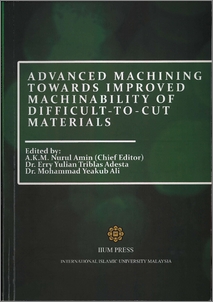Hossain, Ishtiaq and Amin, A. K. M. Nurul and Patwari, Muhammed Anayet Ullah
(2011)
Development of an artificial neural network algorithm for predicting the cutting force in end milling of Inconel 718 alloy.
In:
Advanced Machining Towards Improved Machinability of Difficult-to-Cut Materials.
IIUM Press, Kuala Lumpur, Malaysia, pp. 143-148.
ISBN 9789674181758
![[img]](http://irep.iium.edu.my/style/images/fileicons/application_pdf.png)  Preview |
|
PDF (Development of an artificial neural network algorithm for predicting the cutting force in end milling of Inconel 718 alloy)
- Published Version
Download (561kB)
| Preview
|
Abstract
To predict the required cutting force is necessary to realize the potentials of difficult-to-cut
materials and get better efficiency. Cutting force is a critical and important target while
machining because the change of it will affect surface finish, tool wear, vibration etc. The forces
that are developed during the milling process can directly or indirectly measure/estimate process
parameters of end milling such as, tool life, tool wear, surface finish etc. For the instance,
excessive cutting forces generally result in low product quality while small cutting forces often
indicate low machining efficiency [1]. Therefore controlling these forces is of vital importance.
Because of its paramount significance, researchers have been trying to develop mathematical
models that would predict the cutting forces based on the geometry and physical characteristics
of the process. A.S. Mohruni et al [2] developed the cutting force models where the primary
machining parameters such as cutting speed, feed and radial rake angle were used as independent
variables for factorial design of experiment coupled with response surface methodology (RSM).
Kuang-hua fuh et al proposed a predicted milling force model for the end milling operation. In
that study, the spindle rotation, feed, axial and redial depth of cut are considered as the affecting
factors and an orthogonal rotatable central composite design and the response surface
methodology were used to construct the model [3]. Such prediction could then be used to
optimize the process. Nonetheless, due to its complexity, the milling process still poses a
challenge to the modeling and simulation research effort. In fact, most of the research works
reported pertained to this are based on either analytical or semi-empirical approaches, has in
general shown only limited levels of accuracy and/or generality.
ANN offers an alternative way to simulate complex and ill defined problems. As the machining
process is nonlinear and time-dependent, it is difficult for the traditional identification methods
to provide an accurate model. Compared to traditional computing methods, the artificial neural network (ANN) is robust and global. ANN has the characteristics of universal approximation,
parallel distributed processing, hardware implementation, learning and adaptation, and
multivariable systems. Because of this, ANN is widely used for system modeling, function
optimizing, image processing, and intelligent control. ANN gives an implicit relationship
between the input(s) and output(s) by learning from a data set that represents the behavior of a
system [4].
In the present paper, a different approach that is based on advanced artificial intelligence
techniques is implemented and tested. More specifically two different neural networks are used
to predict the forces developed during End milling. The network is selected based on certain
criteria.
Actions (login required)
 |
View Item |


 Download Statistics
Download Statistics Download Statistics
Download Statistics